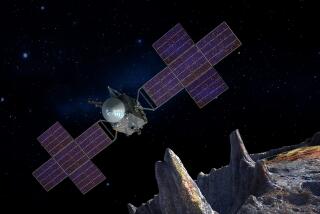NASA’s Mars InSight has traveled 300 million miles. The last one will be the most critical
- Share via
On Sunday, about a dozen engineers and scientists gathered in the mission control room at NASA’s Jet Propulsion Laboratory. They listened intently through headsets while training their eyes on a curving wall of monitors to follow the progress of the InSight spacecraft as it made its final approach to Mars.
Had it received their message through 90 million miles of cosmic nothingness?
It had. Just before 2 p.m., InSight fired its thrusters and banked a hair to the southwest.
It would be a few more hours until the members of the InSight team would learn that their maneuver had worked as planned. Even so, the group gathered in La Cañada Flintridge breathed a collective sigh of relief.
“We are going to hit Mars, no matter what,” said JPL’s Bruce Banerdt, the principal investigator for the InSight mission.
But that’s not the goal. Banerdt’s team had been tweaking the spacecraft’s trajectory throughout its winding, 300-million-mile game of interplanetary tag in hopes of guiding InSight to a carefully selected landing spot.
“It’s sort of like curling,” he said. “The stone’s moving on the ice, and we are sweeping at this point.”
RELATED: NASA’s InSight lander is about to touch down on Mars, and you can follow live right here »
If the team nudges InSight just right, the lander will touch down around noon Monday on Elysium Planitia, a vast, featureless expanse of ancient lava a few hundred miles north of where the Curiosity rover landed in 2012. There, it will do something no previous mission has managed: Peer inside the red planet.
Armed with an arsenal of specialized instruments, InSight will take Mars’ temperature, monitor its seismic activity and investigate the nature of its core. Scientists hope the results will not only answer their questions about Mars, but about how planets in general work — how they form and evolve over time, and how deep geologic processes determine whether the surface of a planet might be habitable.
“That’s what we need to be able to extrapolate from Mars to exoplanets,” said geophysicist Suzanne Smrekar, the deputy principal investigator for the mission.
But before the science gets underway, the InSight team must pull off the equivalent of a gold medal curling match.
InSight’s interplanetary journey got off to a fine start when it launched from California’s Vandenberg Air Force Base on May 5.
RELATED: Apollo missions to the moon set the stage for InSight’s mission to Mars »
“The cruise has been going so smooth,” Banerdt said. “It’s really been almost eerie.”
His team even skipped one of the previous scheduled trajectory correction maneuvers. They didn’t need it.
Still, Banerdt can’t help feeling nervous about the complex choreography that comes next, even if it’s nothing new.
InSight will follow the same entry, descent and landing procedure as NASA’s Phoenix lander, which safely touched down near the Martian north pole in 2008. “We’re not inventing anything this time,” Banerdt said.
On Monday morning — JPL time — the capsule containing the InSight lander will prepare for arrival by swinging its broad base toward the planet’s surface. The Martian atmosphere may be thin, but it will produce enough friction to heat the spacecraft’s protective shield to 2,700 degrees Fahrenheit, and to slow it from a cruising speed of 12,300 mph to a mere 850.
That’s when InSight’s giant parachute will deploy. Though the move has worked on many previous Mars missions, Banerdt still worries about the potential for a mishap.
At supersonic speeds, “there are things in that regime that we don’t quite completely understand,” he said. “And a parachute is a piece of cloth, for goodness’ sake.”
Next, the lander will discard its fried heat shield and stretch its three robotic legs for the first time in its long journey. Then, it will use radar to sense its altitude — another heart-stopping moment for the InSight team.
“If the radar doesn’t ever see the ground, then there’s no way for the lander to know when to slow down,” Banerdt said.
When InSight reaches an altitude of a few thousand feet, it will ditch the shell covering its precious payload. Finally, it will fire 12 retrorockets mounted on its underside, slowing the lander to approximately 5 mph so it can descend to the surface of Mars like a commuter stopping at a red light.
Just a touch faster than a curling stone coming to rest on Olympic ice.
Banerdt and the crew at JPL intend to track InSight’s progress throughout the entry, descent and landing with the help of two experimental briefcase-size satellites that have accompanied the spacecraft on its mission. If these fail to relay signals for any reason, the team will get final confirmation of InSight’s arrival when sensors on the landers’ legs trigger a high-frequency beep, detectable by giant radio antennas on Earth.
Then the real work can begin.
InSight will operate for 728 days, a bit more than one Martian year, and perhaps longer (if NASA’s long-lived orbiters and rovers are any guide).
“Who knows what we’ll find,” Smrekar said. “It’ll be fabulous.”
For Banerdt, the excitement began to build a few weeks ago, when the team started rehearsing for landing. “It felt pretty real at that point,” he said.
On Monday, the team will find out if they hit their target.







